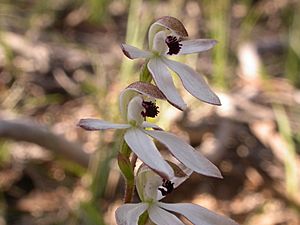Hooded caladenia facts for kids
Quick facts for kids Hooded caladenia |
|
|---|---|
 |
|
| Caladenia cucullata growing on Black Mountain in the A.C.T. | |
| Scientific classification | |
| Genus: |
Caladenia
|
| Species: |
cucullata
|
| Synonyms | |
|
Stegostyla cucullata (Fitzg.) D.L.Jones & M.A.Clem. |
|
The Hooded Caladenia (scientific name: Caladenia cucullata) is a special type of orchid plant. It's often called the "hooded caladenia" because of how its top petal looks like a hood. This plant is found only in south-eastern Australia. It grows in the ground and has one slightly hairy leaf. When it blooms, it can have up to seven white flowers. Each flower has a pretty purplish part called a labellum.
What Does It Look Like?
The Hooded Caladenia is a plant that grows from an underground tuber. It's a perennial plant, meaning it lives for more than two years. It's also a deciduous herb, which means its leaves fall off at certain times of the year.
This orchid has one long, thin leaf that is slightly hairy. It can be about 6 to 20 centimeters (2.4 to 7.9 inches) long and 1 to 6 millimeters (0.04 to 0.24 inches) wide.
The Flowers
The Hooded Caladenia can have up to seven white flowers. These flowers grow on a tall stem, or spike, that can be 10 to 35 centimeters (3.9 to 13.8 inches) high. Each flower is about 10 to 35 millimeters (0.39 to 1.38 inches) wide.
The flower has several parts:
- Sepals and Petals: The side sepals and petals are narrow and spread out. They are about 8 to 13 millimeters (0.31 to 0.51 inches) long. The outside of these parts has tiny green or brown glands. The inside is smooth and white. The petals are a bit shorter and narrower than the sepals.
- Dorsal Sepal: The top sepal is shaped like an egg. It stands upright at the bottom but then bends sharply, forming a "hood" over the center of the flower.
- Labellum: The labellum is a special lip-like part of the orchid flower. It's mostly egg-shaped, about 5 to 7 millimeters (0.20 to 0.28 inches) long. It is white with reddish-purple marks and a dark purple, pointed tip. The sides of the labellum are wavy and stand upright, and its tip curves strongly downwards.
- Calli: On the labellum, there are four neat rows of thick, club-shaped bumps called calli. These calli get smaller towards the tip of the labellum.
- Column: The column is the central part of the flower where the reproductive organs are. It bends forward, has wavy edges, and is covered with red spots.
The Hooded Caladenia usually blooms from September to November.
How It Got Its Name
The Hooded Caladenia was first officially described in 1876 by a botanist named Robert D. FitzGerald. He published his description in a book called Australian Orchids.
The scientific name cucullata comes from a Latin word, cucullus. This word means "cap" or "hood," which perfectly describes the hooded shape of the flower's top sepal.
Where Does It Grow?
The Hooded Caladenia likes to grow in forests. It usually prefers poor, sandy, or stony soil.
You can find this orchid in different parts of south-eastern Australia:
- In New South Wales, it grows on the tablelands and western slopes, south of Dubbo.
- In Victoria, it is quite common and can be found in many areas, especially in the goldfields.
- In South Australia, it is not as common. It has only been found in the very south-east corner, close to the border with Victoria.

